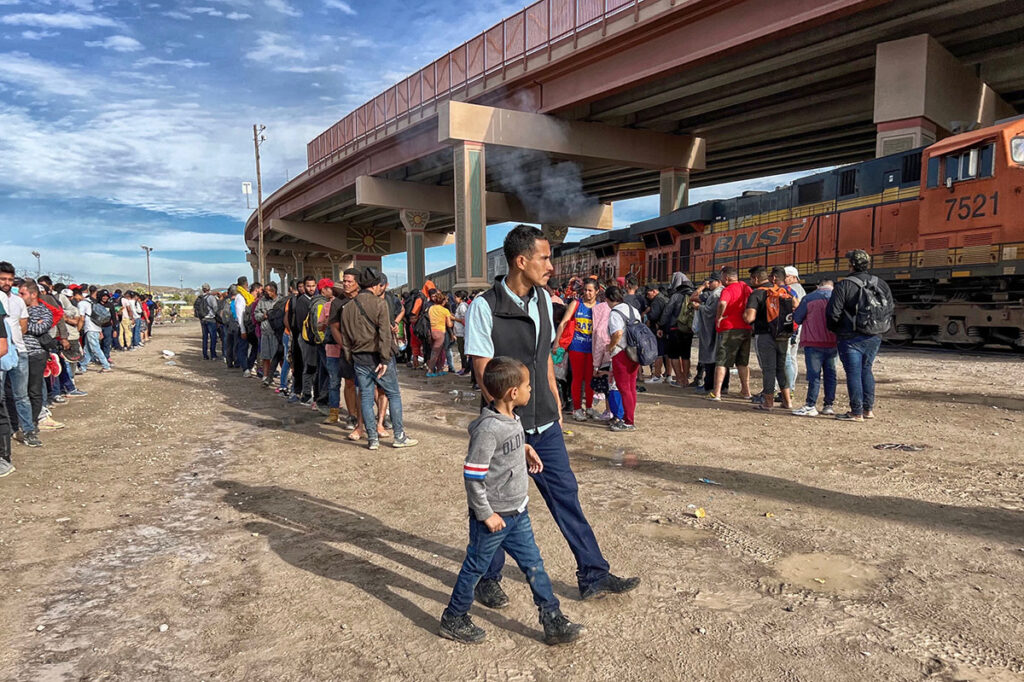
IN CHIHUAHUITA, TEXAS | Crowd of Venezuelan migrants recently arrived in the US. (Photos/ Morgan Smith and Laurie Smith)
VISITING MONTE CRISTO REY AND CHIHUAHUITA
Haga click aquí para leer la versión en español
Morgan Smith y Laurie Smith
It’s 6 AM and still dark but the rain has ended as we meet in the parking lot at the Sunland Park, New Mexico Police Department. Our group includes Laurie Smith, a photographer from Denver, me and three Border Patrol agents, Landon Hutchens from Texas who has organized this early morning ride-along plus Carlos Rivera and Orlando Marrero, both of whom were born in Puerto Rico.
I’ve been traveling to the border and documenting conditions in the El Paso-Juárez area for the last decade and Laurie grew up in El Paso so we’re not beginners. Nonetheless, neither of us knows what to expect and what we will see. Within five minutes of leaving the Police Station, we suddenly encounter four migrants who had come down the steep, treacherous slopes of Monte Cristo Rey and dashed across the highway in front of our vehicle.
The agents quickly detain them, have them take off their belts and shoelaces, place personal items like cell phones in plastic bags, give them receipts for these personal items, and search them. One migrant from Coahuila, Mexico has obviously been through this procedure before and knows exactly what to do. Two other men, one from Guatemala, look devastated. They have invested thousands of dollars in this trip, hoping that it will lead to decent jobs in the US.
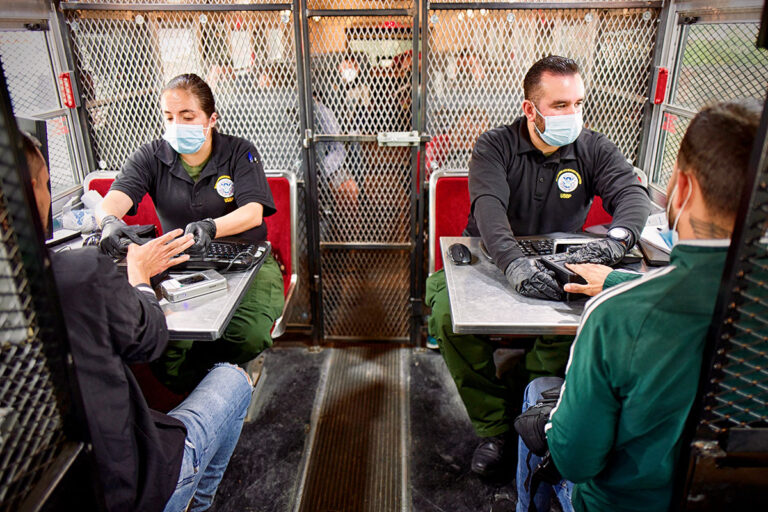
MOBILE UNITS| Border Patrol Processing Center.
The “coyote” and the migrants
One of the agents said that the fourth man who was much heavier was probably the “coyote.” “He wouldn’t be that fat if he had come all the way from Central America,” he said. We almost immediately run across a second group. From Ecuador, they are slightly better dressed. The third group includes a woman and her terrified 8-year-old daughter. You wonder how desperate they were to have come over this rugged mountain in the semi darkness.
The woman says she is a diabetic so Orlando who is an EMT immediately decides for her to be taken to medical care. So far, this fiscal year (ending on September 30) the Border Patrol has had 18,897 rescues. This compares to 12,833 in the 2020-21 fiscal year and includes many water-related rescues as well as falls from the wall. Therefore, the medical care provided by EMTs like Orlando is an essential part of the Border Patrol’s mission.
We then drive to the border wall between Anapra, Mexico, and Sunland Park. I go there every time I’m in the area and follow the wall eastward where it ends so that I can talk to the Mexican soldiers who patrol the Mexican side. I went there the day before and saw that the Mexican soldiers had detained four Salvadorans who had attempted to cross. I had never seen this before and frankly had been skeptical of their commitment to controlling the wall.
Visiting the surveillance tower
This time, however, we drive westward; the agents want to show us a new surveillance tower. We immediately see where a red cross has been painted on the wall. This was where in late March 2021 two sisters from Ecuador, age 3 and 5 were dropped over the wall by smugglers. Because of the availability of this surveillance system, the whole incident was filmed and Border Patrol agents were quickly able to rescue the little girls. Otherwise, they could have died from exposure.
This marker is one indication of the cruelty of what is a highly organized, multi-billion dollar smuggling industry that originates in the Latin American countries from which the migrants come, stretches through Mexico into the United States where migrants are often held in stash houses and forced to come up with even more money if they want to be freed. ( There is recent good news that a smuggling ring in south Texas was just dismantled and a number of smugglers arrested and indicted. The investigation involved officials from Mexico. Guatemala, Honduras and El Salvador, a sign of much-needed international cooperation.)
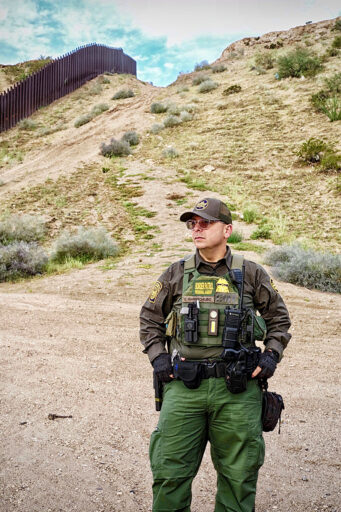
BORDER WALL BETWEEN ANAPRA AND SUNLAND PARK| Marrero, a Border Patrol agent.
Our next stop is the Chihuahuita area of El Paso next to the railyard where there is a gap between two sections of the wall through which asylum seekers can pass in order to turn themselves in to the Border Patrol. We expect a small number of migrants there but are stunned to see a crowd of 300 to 400, mostly men and almost all from Venezuela.
Venezuelan exodus
Why Venezuela when the countries we typically talk about are Guatemala, Honduras, and El Salvador? Other than Syria, no country in the world has had a mass exodus that matches that of Venezuela. Roughly 25 percent of its population has fled because of poverty, corruption, and violence. For us Americans, however, this exodus has been somewhat disguised because most of those fleeing their country have gone south mainly to Colombia but also Peru and Ecuador.
Now they are making the highly dangerous trip north across the remote, roadless and highly dangerous Darien Gap on the border with Panama. This crowd at Chihuahuita looks overwhelming but the Border Patrol contingent – less than 6 officers when we first arrive – has organized them in lines. Some are tired and scared as can be expected but many are cheerful, anxious to pose for photos and to describe their experiences and their hopes for the future.
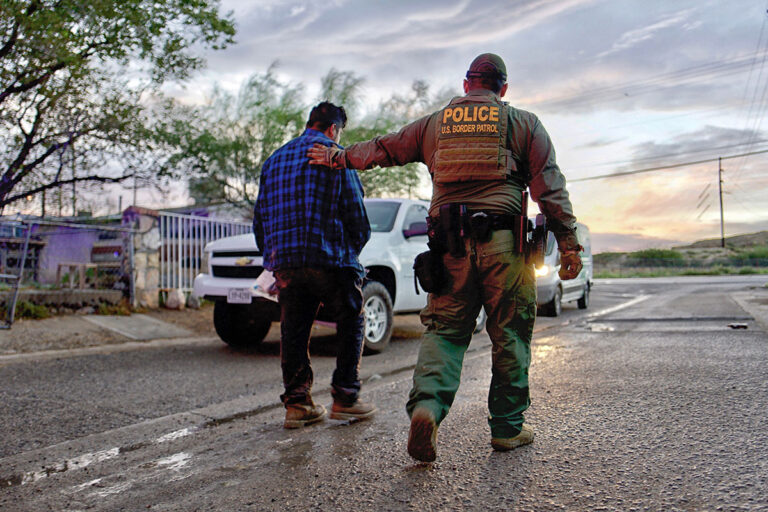
AT SUNLAND PARK | Border Patrol arrests of migrants at the base of Monte Cristo Rey.
Border Patrol mobile processing center
The Border Patrol has set up mobile processing centers using retrofitted school buses. Despite these enormous numbers of migrants, the processing begins to move quickly. Our agents say that morale is much higher than it was back in 2019 when they struggled with the surge of migrants and that they have made many improvements like the surveillance tower we saw earlier and a new Central Processing Center that is designed for 1,700 migrants.
Perhaps more important, there is a powerful working relationship with the City of El Paso which is discussing another processing center and volunteer organizations like Annunciation House. By late morning when our ride-along ends I am frankly exhausted, but the day is only half over for Agents Hutchinson, Rivera, and Marrero. Here are some of my reactions.
Our balance
First, I can’t thank Agents Hutchens, Rivera, and Marrero enough for this experience. What was continuously obvious throughout the morning – both during the detentions near Monte Cristo Rey and the processing of the huge crowd at Chihuahuita – was their professionalism and courtesy as well as that of the other Agents we observed. To quote Agent Marrero, “I do it with dignity and respect towards the migrants, make sure that they’re safe
Second, despite the intensifying political debate about the border and immigration, the reality is that the Border Patrol is doing a remarkable job of securing our border with the tools they have. Third, roughly ninety five percent of the migrants we saw on September 13 had crossed the border peacefully and turned themselves in to exercise their legal right to ask for asylum.
Last, a closing quote from Agent Marrero that sums up my memory of this unique morning., “It takes a lot for me not to be in a good mood.” These agents approached their very difficult work with dignity and commitment but also with good humor.
You may also like:
Latin American talent shone at LFWC 2022





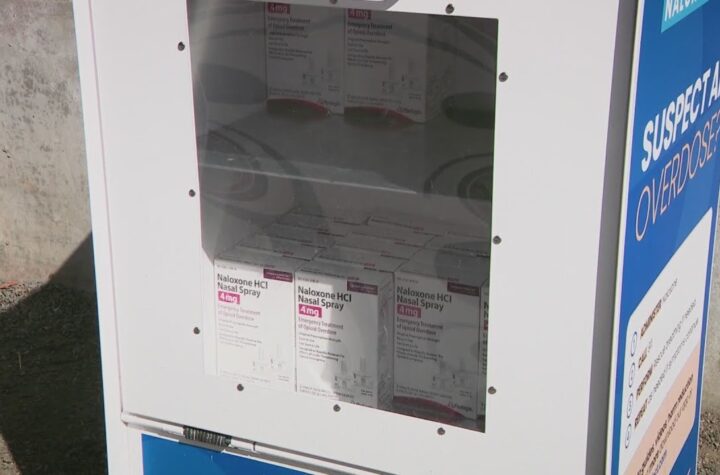
otras noticias
Hello Catira! Venezuelan flavor with soul
Colorado Rush invites kids to play, grow, and dream
Innovative plan at Adams 14 school gets green light